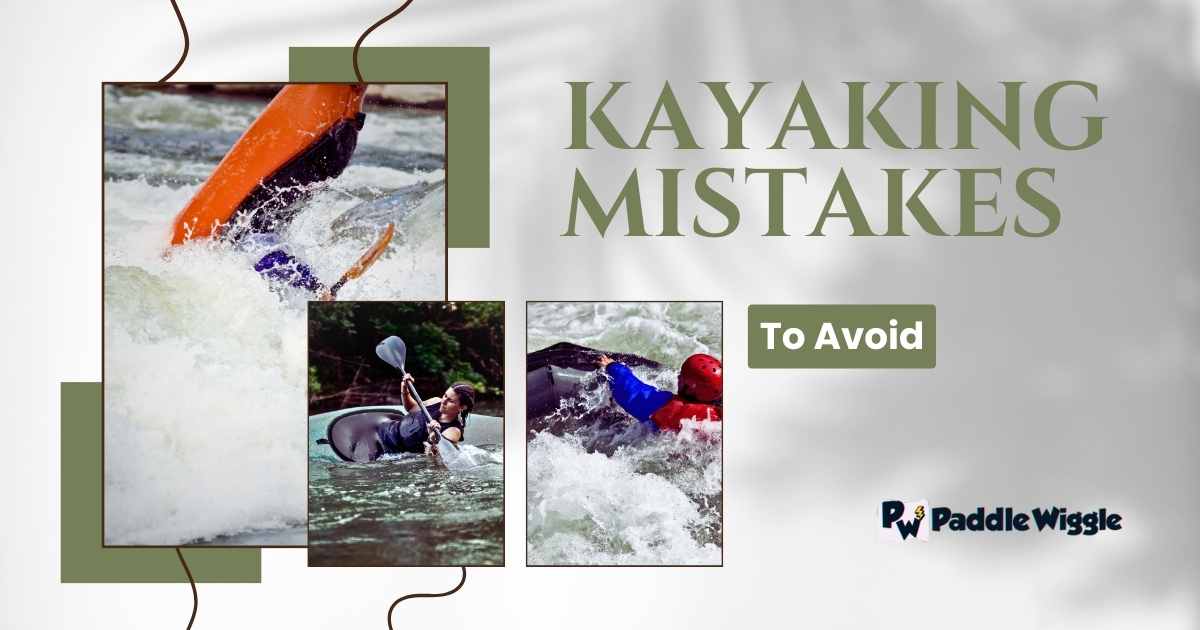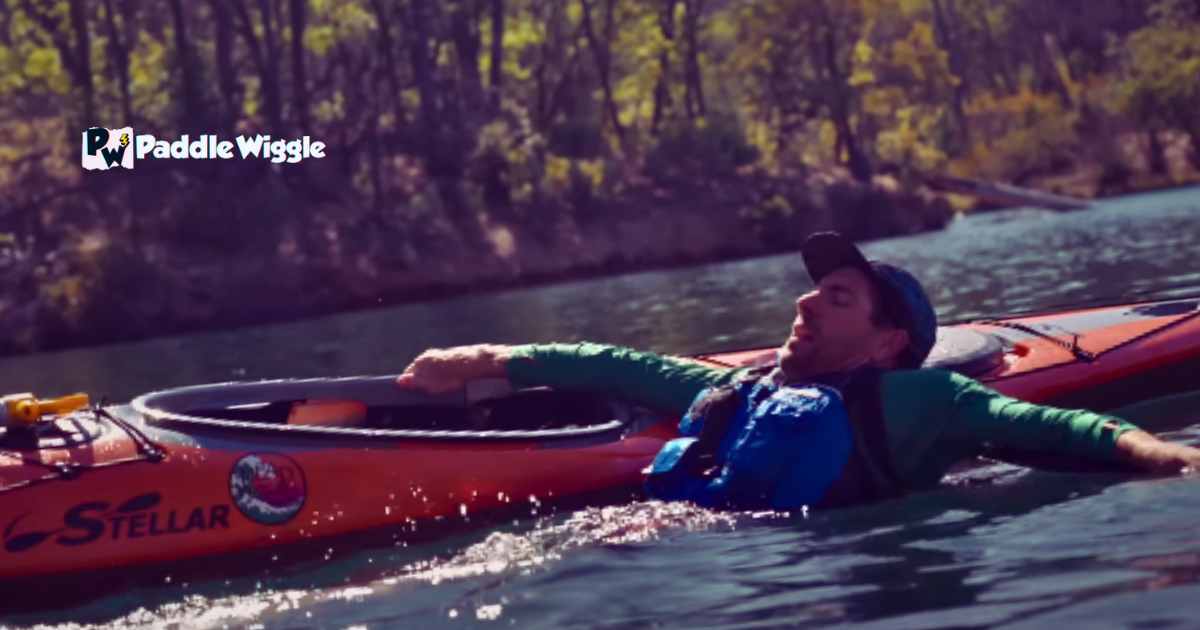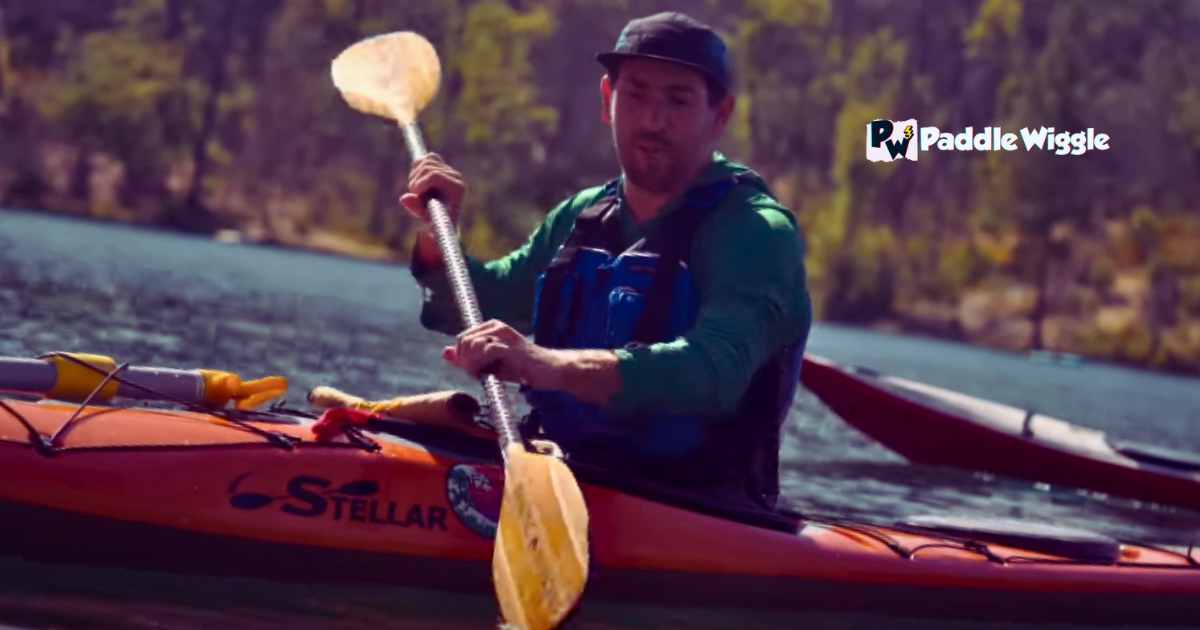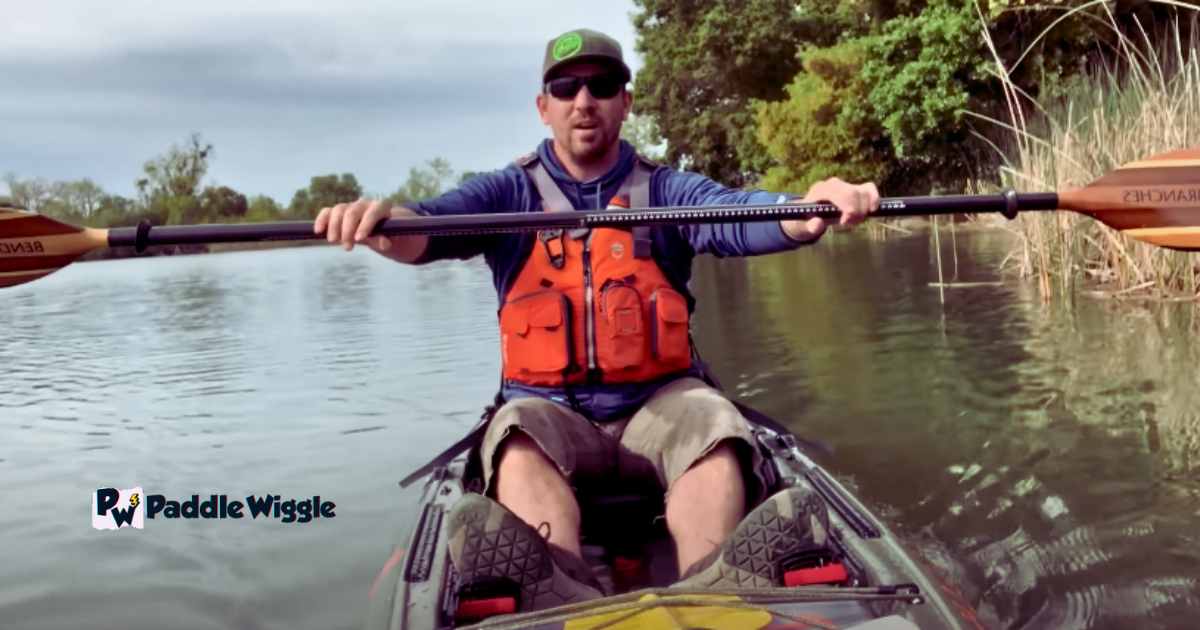Did you know that a big 80% of kayaking accidents happen because of mistakes you could easily avoid? It’s true! These mistakes can be as simple as not getting ready properly, using the paddle wrong, or not using your gear the right way. But they can lead to some serious problems like tipping over or getting hurt.
Kayaking is a really exciting outdoor activity where you paddle through all kinds of water. But like any adventure sport, it has its challenges. Even people who are really good at kayaking can make mistakes sometimes.
Understanding these kayaking mistakes is super important for kayakers because it keeps them safe, makes their trips more fun, helps them get better at kayaking, and takes care of the environment they’re in.
In this research, we’re going to explore the world of kayaking and talk about the seven common mistakes to avoid when kayaking. These mistakes can be anything from poor planning and preparation to navigational errors!
Even though they might seem small, they can cause accidents injuries or just make your kayaking trip not as great as it could be.
Let’s get started.
In this research


The 7 Common Mistakes In Kayaking
When you go kayaking, it’s important to avoid some common mistakes that can make your experience less fun. Let’s look at seven of these mistakes to make sure you have a great time on the water.
Mistake #1: Poor Preparation
First, let’s talk about how getting ready before you go kayaking is really important. Not preparing well can make things hard on the water and might even be dangerous for you. So, let’s dive into why it is crucial to plan ahead and make sure you have everything in order.
One of the primary aspects of preparation is checking the weather conditions. Failing to do so can have serious consequences for your kayaking trip. Imagine setting out on a beautiful sunny day, only to be caught in a sudden storm or strong winds. It can be dangerous and make it difficult for you to navigate and control your kayak. Always check the weather forecast before you go, and be prepared for any changes that may occur during your trip.
Another significant aspect of preparation is planning your route. Don’t just go kayaking without thinking – it’s important to plan your route. This means thinking about possible obstacles like rocks and strong currents. It also helps you know how long your trip will be and make sure you won’t be on the water when it gets dark.
Many people forget about getting their bodies ready, but it’s super important for a fun kayaking time. Kayaking requires you to be strong and have good stamina, especially for long or tough trips. If you don’t prepare your body, you might get tired, get muscle cramps, or even hurt yourself while kayaking.
To avoid this mistake, make sure you are physically fit before embarking on a kayaking trip. Doing exercises often that work on your core and upper body muscles will make you better at paddling and give you more stamina.
Let’s summarize the key points:
- Not checking weather conditions can lead to unexpected storms or strong winds during your kayaking trip.
- Failing to plan the route may expose you to potential hazards or obstacles along the way.
- Overlooking physical preparation
Mistake #2: Poor Kayak Handling


Improper kayak handling can lead to a whole lot of trouble out on the water. From launching and landing to steering and maneuvering, it’s important to know how to handle your kayak correctly. Let’s dive into some key points that will help you improve your kayak handling skills.
How to correctly launch and land a kayak?
Launching and landing your kayak may seem simple, but there are a few important things to keep in mind. When launching, make sure you’re in an area with enough space and avoid shallow waters or rocky areas. To properly launch your kayak:
- Position yourself beside the kayak with one foot inside.
- Hold onto the paddle securely.
- Push off from the shore using your other foot while maintaining balance.
- Once you’re in deeper water, hop into the kayak quickly but carefully.
Landing is just as crucial as launching:
- Approach the shoreline slowly, keeping an eye out for any obstacles.
- Use your paddle as a rudder to guide yourself towards the shore.
- As you reach shallow water, lift your knees slightly to prevent scraping the bottom.
- Step out of the kayak once it’s close enough to land.
What are the key points to remember for effective steering and maneuvering?
Steering and maneuvering your kayak requires proper technique and practice. Here are some essential tips:
- Grip your paddle correctly: Hold it with both hands, making sure they’re about the width of your shoulders apart and one hand is above the other.
- Focus on body positioning: Sit up tall and straight, keep your back in a good position, and use your core muscles to stay stable.
- Use smooth strokes: Don’t make sudden or rough movements while paddling. Instead, use smooth, flowing motions for better control.
- Please pay attention to weight distribution: Spread your weight evenly in the kayak to make it more balanced.
How can one maintain proper balance in a kayak?
Maintaining proper balance in a kayak is essential for stability and control of the water. The easiest way to maintain balance in a kayak is to keep your center of gravity low and centered in the kayak. Sit with your back straight and your feet resting on the footrests or against the bulkhead. Your knees should be slightly bent, allowing you to use your legs for support and control.
Here are some tips to help you achieve and maintain balance while kayaking:
Paddle Placement
Hold the paddle with both hands and make sure your hands are shoulder-width apart. Keep your elbows slightly bent. Avoid gripping the paddle too tightly, as this can lead to tension and instability.
Posture
Maintain good posture throughout your kayaking journey. Make sure your back is straight, and your shoulders are relaxed. This way, your weight will be spread evenly, and you’ll have better balance. Avoid slouching or leaning too far forward or backward.
Use Your Core Muscles
Engage your core muscles to help stabilize your body. This involves using your abdominal and lower back muscles to maintain balance. A strong core can significantly improve your kayak stability.
Hip Movements
Practice controlled hip movements to shift your weight within the kayak. This helps you counteract any tipping or rocking motion. Experiment with gentle hip movements while keeping your upper body steady.
Paddle Strokes
Use proper paddle strokes to help maintain balance. A balanced and controlled stroke technique minimizes the risk of capsizing. Ensure your strokes are fluid and even on both sides.
Mistake #3: Navigation Errors
Kayaking navigation might seem easy, but you need to watch out for mistakes that can make you get lost or go the wrong way. Let’s take a closer look at some navigation errors and how they can be avoided.
Disregarding water currents and wind direction
One common error is not thinking about how water currents and wind can affect your kayaking trip. If you ignore these things, it can be easier to control your kayak and stay on the right path.
To deal with this, you need to know how water currents and wind direction impact your kayak. If you’re paddling against a strong current or headwind, it’s harder and makes you slower. But if you go with the flow or have the wind at your back, you can travel further with less effort.
Failing to use navigational tools effectively
Another navigation error is failing to utilize navigational tools effectively while kayaking. Using tools like compasses or GPS devices is really helpful. They help you figure out where you are, see how far you’ve gone, and make sure you stay aware of the situation.
If you’re just starting out with kayaking, it’s important to learn some simple navigation skills and get the hang of using tools like maps and compasses. Knowing how to read a map and use navigation tools will help you paddle the right way and not get lost.
Ignoring signage or warnings
Another mistake in navigating is not paying attention to signs or warnings on the water. These signs might tell you about dangers like rocks under the water, fast currents, or places you shouldn’t go for safety.
If you ignore these signs, you could get into accidents or end up in dangerous situations. So, it’s important always to pay attention to the signs along your route and follow any instructions from authorities.
Mistake #4: Flawed Paddling Techniques


In the world of kayaking, it’s important to paddle efficiently and effectively. However, many paddlers need to correct their paddling techniques that hinder their performance and cause unnecessary fatigue. Let’s take a closer look at some of these flaws and how they can be rectified.
Incorrect Grip on the Paddle
One of the most fundamental aspects of kayaking is having the correct grip on your paddle. Sometimes, when people paddle, they hold the paddle too tight or don’t hold it right. This can make you feel uncomfortable and make it harder to paddle strongly with each stroke.
To avoid this problem, make sure to hold your paddle with a loose grip so it can move easily. Put your hands about the width of your shoulders apart, with one hand on top of the paddle and the other hand a bit lower down. This grip will provide you with better control and efficiency while paddling.
Ineffective Paddling Strokes
Another common mistake that paddlers need to correct is using inefficient paddling strokes. Using the paddle wrongly or not doing it the same way each time can really make kayaking harder and less fun.
To improve your paddling strokes, focus on proper blade placement in the water. When you put the paddle into the water, make sure the flat part of the blade is facing the back. This way, you can go forward easily. Also, keep a steady and even pace when you paddle to make it work best.
Overuse of Arm Strength Instead of Torso
Some new kayakers need to use more arm power instead of using their core muscles. If you only use your arms, you’ll get tired fast, especially on long trips.
Instead, try to use your core muscles. When you paddle with one arm, turn your body at the same time to get power from your whole body, not just your arms.
Mistake #5: Incorrect Equipment Usage
Using the right equipment is crucial for a safe and enjoyable kayaking experience. Regrettably, lots of folks use their kayaking gear the wrong way, and that can lead to problems. We’ll check out how using equipment the right way is important for your kayaking trips.
Improper selection of kayak and gear
One common mistake is choosing the wrong kayak or gear for your specific needs. The kayak you pick should match your skills, the water you’ll be on, and what you want to do while kayaking. If you use a kayak that doesn’t fit you or isn’t right for your plans, it can make it tough to stay balanced and steer well on the water.
Wrong way of wearing a life vest
Another error that people often need to correct is wearing their life vest incorrectly. A life vest is a vital piece of safety equipment that can save lives in case of an accident. However, if it’s not worn properly, it may not be effective when needed most. For example, wearing a life vest too loose or without securing all the straps may cause it to ride up or even come off in turbulent waters.
Incorrect handling and storage of equipment
Properly handling and storing your kayaking equipment is essential for its longevity and functionality. These aspects must be revised to avoid damage or deterioration over time. For example, if you leave your gear out in the hot sun or very cold weather, it can make materials like plastic or fabric weaker. If you put away wet gear without letting it dry properly, it might start growing mold or mildew.
To avoid these mistakes and ensure your safety on the water:
- When you’re picking kayaks and gear, it’s a good idea to ask experts for help. Talk to experienced kayakers or instructors who can suggest the right choices for you.
- Follow manufacturer instructions: To use your gear the right way, read the manuals that come from the companies that made them.
Mistake #6: Neglecting Safety Measures
Neglecting safety measures while kayaking can have serious consequences. It’s important to prioritize safety on the water to ensure a fun and secure experience. Let’s take a closer look at some common mistakes and why it is crucial to avoid them.
Not Wearing a Life Vest or Personal Flotation Device (PFD)
One of the biggest mistakes kayakers make is not wearing a life vest or PFD. These things are made to help you stay on the surface if something bad happens, like if your kayak flips over or you fall out. If you don’t use them, you could be in danger of drowning, especially if you’re not a good swimmer.
Kayaking Without a Safety Plan or Buddy
Going out alone without any support can be dangerous, especially for beginners. It’s important to have a safety plan in place before heading out on the water. This includes informing someone about your trip details, such as where you’ll be kayaking and when you expect to return. Having a buddy system ensures that there is someone who can help in case of an emergency.
Neglecting to Learn Self-Rescue Techniques
Another mistake many beginners need to pay more attention to learning self-rescue techniques. It’s really important to learn how to climb back into your kayak if it flips over and how to help someone if they’re in trouble. This is not just for your safety but for the safety of others. If you don’t learn these things, you might end up stuck in the water without knowing how to get back in your kayak.
Remember that not taking safety seriously can be really bad for everyone, whether you’re new to kayaking or have lots of experience. Here are some reasons why prioritizing safety is essential:
Mistake #7: Lack of Practice and Training


Regular practice and training are essential for improving your kayaking skills. Lots of newbies think they’ll get really good right away without practicing much. But if you practice regularly, it’s easier to get better at kayaking.
One of the key benefits of regular practice is the improvement in technique. When you go on the water and practice different ways of paddling, you’ll get better at controlling your kayak. This means you can easily and confidently handle different types of water.
Another advantage of regular practice is increased stamina. Kayaking requires you to be strong and have good stamina, and you can get better at it by training regularly. If you slowly paddle longer and longer, you’ll get fitter and be able to handle longer kayaking trips.
Moreover, practicing regularly helps boost your confidence on the water. As you get better at kayaking and gain experience, you’ll get more comfortable with trying new things. Confidence is important because it helps you go further and try new techniques or go to new places for kayaking.
To enhance your kayaking abilities, consider learning from experienced kayakers. They have valuable knowledge that can help you improve your skills more efficiently. Seek out opportunities to paddle with experienced individuals or join local kayaking clubs where you can learn from their expertise firsthand.
Taking part in kayaking courses or training programs can greatly benefit beginners. These programs often provide structured lessons that cover everything from basic paddling techniques to advanced maneuvers. They also offer guidance on safety practices and equipment usage.
If you join these classes or workshops, you’ll get lessons from experts made just for beginners. This will make you learn faster and make sure you start with the right way of doing things.
Understanding Why Kayaking Newbies Go Off Course
People who are new to kayaking often end up going off the path they meant to take for different reasons. Let’s look at some of the things that make this happen and understand why.
#1. Failing to Learn Basic Skills and Drills
New kayakers need to learn the basics to stay on track and have a safe and fun time on the water. If they don’t, they might get into trouble, like flipping over or getting tired fast.
One of the essential skills that beginners often overlook is the wet exit technique. This skill is about getting out of the kayak if it flips over, which can happen to even experienced kayakers. Knowing how to do a wet exit not only keeps you safe but also lets you take control of the situation quickly.
New kayakers should also learn how to rescue themselves and help others if their kayak flips over. If there’s a capsize, being able to flip your kayak back or help others do it is important for everyone’s safety. These techniques have special moves and plans that you need to practice a lot to get good at them.
Efficient paddling techniques are also vital for beginners to learn early on. Using the paddle the right way helps you steer better and save energy on longer trips. When you learn how to do paddle strokes like the forward stroke, sweep stroke, and draw stroke well, you can paddle easily and have more fun on your kayaking trips without getting too tired.
Acquiring these fundamental skills and practicing essential drills provides several benefits:
Handle unexpected situations
When you learn the basics, you’re ready for unexpected things that might happen while kayaking. If the weather changes suddenly or the water gets rough, knowing what to do makes you feel confident about dealing with these situations.
Enhance paddling efficiency
When you know the right way to paddle, you can do it more easily, so you stay energized. That means you can go longer distances without feeling completely worn out.
#2. Overestimating Their Physical Stamina and Skills
In the last part, we discussed how important it is to learn basic kayaking skills. Now, we’ll look at another mistake beginners often make: thinking they’re stronger and better at kayaking than they really are.
It’s easy to get caught up in the excitement and adrenaline rush. A lot of beginners think kayaking is easy, just paddling on calm water. But it can be tough and needs some skill to do it right.
One reason people overestimate their kayaking abilities is that they need to learn all the details that make kayaking work well. Newcomers might need to learn there are different kinds of kayaks made for different situations, like long trips or rough rapids. Without this knowledge, they might pick a kayak that doesn’t match what they want to do or how skilled they are.
Another area for improvement is not getting lessons before going kayaking as a beginner. Experienced instructors can teach you important things like how to paddle right, stay safe, and find your way. If you complete this, you can get through with helpful info that can keep you from getting into trouble.
Being too confident can make beginners try really long trips or go to places they need more time to be ready for. They might paddle far from the shore without realizing they’ll get tired fast or that it’s hard to paddle against strong currents or winds. Not getting ready properly not only makes them unsafe but it also makes it more likely they’ll get lost or stuck.
To avoid these pitfalls, it’s crucial for beginners to gradually build their stamina, strength, and skill through progressive training. Here are some tips:
Start with shorter trips
Begin by paddling shorter distances close to the shore. This allows you to get accustomed to the feel of the kayak and the rhythm of paddling without venturing too far from safety.
Gradually increase the trip length
As you gain confidence and endurance, gradually increase the length of your kayaking trips. Challenge yourself to explore new areas and gradually extend your paddling time.
Invest in comfortable gear
Invest in a comfortable kayak seat, paddle, and safety equipment. Comfortable gear can significantly reduce discomfort and fatigue during extended trips.
Build strength and flexibility
Regular exercise and strength training can improve your overall fitness, making it easier to handle longer kayaking excursions. Focus on core and upper body strength as they are crucial for paddling.
#3. Misjudging Weather and Water Conditions
Before you go kayaking, it’s very important to know how the weather and water conditions can affect your trip. Some newbies need to realize how much these things matter, and that can be risky and make you go the wrong way.
One common error is disregarding changing weather patterns. Mother Nature can be unpredictable, with sudden storms or shifts in wind speed that can make paddling difficult. It’s essential to check the weather forecast before setting out on your kayaking trip to avoid being caught off guard.
Another mistake new kayakers often make is not understanding water currents and tides. These natural forces can significantly affect your ability to navigate and stay on course. Strong currents can push you off track or even capsize your kayak if you need more preparation. By familiarizing yourself with water currents and tides, you’ll be better equipped to plan your route accordingly.
So why is it important to check weather and water conditions before kayaking? Let’s dive into a few reasons:
- Safety: Checking the weather allows you to avoid potentially dangerous situations like sudden storms or strong winds that could put you at risk.
- Route Planning: Understanding water conditions helps you plan your route effectively. Paddling with the wind or current rather than against it will save you energy and keep you on track.
- Preparation: It’s good to check the weather and water conditions so you can pack the right stuff. If it’s cold, wearing a wetsuit or dressing in layers will keep you warm and comfy when you go kayaking.
When assessing weather and water conditions, there are several factors that beginners should be aware of:
Wind Speed and Direction
Strong winds can make paddling challenging, especially if they’re blowing against you. It’s important to consider wind speed and direction when planning your trip.
Water Temperature
The temperature of the water you’ll be kayaking on is crucial, particularly if you’re planning longer journeys or paddling in cold conditions. Cold water can lead to hypothermia, even in relatively mild air temperatures. Dress appropriately for the water temperature, and consider wearing a wetsuit or drysuit for added protection.
Tides and Currents
If you’re kayaking in coastal areas or tidal waters, understanding tides and currents is essential. These can significantly affect your paddling speed and direction. Plan your trip to take advantage of tidal currents when possible and be cautious of strong tidal flows.
Wave Height
Waves can make paddling more challenging, especially for beginners. Pay attention to wave forecasts and choose suitable conditions for your skill level. Inexperienced kayakers should refrain from kayaking in large or rough waves.
Water Depth
Shallow water can be a hazard, especially in rocky or uneven terrain. Keep an eye on water depth to avoid running aground or damaging your kayak.
#4. Improper Weight Distribution
Putting things in the wrong spots in a kayak can make it wobble and hard to control. We’ll talk about why putting things right is important in kayaking and the mistakes beginners usually make.
Why is weight distribution important in a kayak?
Proper weight distribution plays a crucial role in ensuring a safe and enjoyable kayaking experience. Here’s why it matters:
- Stability: When you distribute your weight evenly, it helps to maintain the kayak’s balance on the water. This reduces the risk of capsizing and keeps you steady while paddling.
- Control and Maneuverability: If you put your weight in the right place, you can steer your kayak better. This makes it turn smoothly and lets you move easily in all kinds of water.
- Paddling Efficiency: When you put your weight in the right way, it helps you paddle better. This means you can paddle more efficiently, each stroke works well, and you don’t tire your body too much.
What are the common mistakes beginners make in weight distribution?
As a newbie kayaker, it’s easy to overlook proper weight distribution and make some common errors that can affect your overall experience on the water. Here are three mistakes to avoid:
- Loading Heavy Gear on One Side: Placing all your gear or equipment on one side of the kayak creates an imbalance, causing it to tilt towards that side. This not only affects stability but also makes steering more challenging.
- Leaning Excessively While Paddling or Turning: If you lean too much to one side when you paddle or turn, your kayak might tip over or become hard to control.
- Sitting Improperly: If you don’t use the kayak seat or foot braces the right way, it can make the weight in the boat uneven. This can result in instability and difficulty maintaining control.
Beginners Tips For Avoiding Kayaking Mistakes
To have a fun kayaking time, make sure you don’t make the same mistakes beginners usually do. Here are some valuable tips to help you navigate the waters like a pro:
Take a Lesson
Getting lessons from a pro is super important for learning how to paddle right and stay safe. A good teacher can show you how to paddle well, stay steady, and be confident with your kayak. Starting with the right lessons helps you have a strong base for your kayaking trips.
Plan Your Route Accordingly
Before hitting the water, take the time to study the area and plan your route in advance. Consider landmarks and potential hazards along the way. This careful planning will help you stay on track and avoid getting lost or encountering unexpected challenges. Remember, preparation is key!
Use Navigation Tools
It’s important to have tools like maps, GPS devices, or compasses with you. They help you stay on the right path and know where you’re going. These tools are handy if you’re in new places and want to find your way back. When you use good navigation tools, you can explore new areas without worrying about getting lost.
Practice Self-Rescue Techniques
Accidents happen even to experienced kayakers, so it’s crucial to learn basic self-rescue techniques. One such technique involves re-entering your kayak after capsizing. Knowing how to get back into your kayak swiftly can be a lifesaver in emergency situations.
Stay Aware of Wind and Currents
Wind direction and water currents play a significant role in kayaking. You should pay attention and change your direction if you need to. If you paddle against really strong winds or currents, it can be really tiring, and you might end up going in the wrong direction by accident.
If you’re new to kayaking, remember these tips. They’ll help you have a great time. And don’t worry if it’s tough at first; with practice, you’ll get better!
Summary
When you’re into kayaking, knowing stuff is your best friend. Learning about the seven common mistakes to avoid isn’t just about not messing up; it’s about getting better, staying safe, and loving kayaking even more. When you know what can go wrong, you can be a better, safer kayaker.
Every mistake is a chance to learn and grow, so don’t be afraid of them. Use what you learn to become an even cooler kayaker. So, go out there, paddle confidently, be safe, and enjoy the awesome world of kayaking!


